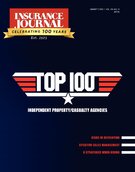Automation is central to many carriers, MGUs and agents as they grow their business and work to keep pace with rapidly advancing technologies. In recent years, underwriting has become much more technology- and data-driven, changing the role of underwriting from what many insurance veterans have become accustomed to.
The traditional underwriting role may still exist in some areas, but we are increasingly seeing companies throughout the industry whose focus is on hiring more technologically trained talent, such as data scientists and developers, as the industry continues to evolve.
With the addition of this new, tech-savvy talent, the underwriter’s role is being redefined at its core, requiring new and different skill sets. This is the face of progress for our industry that represents a new and diverse array of innovative thinking and perspectives that is vastly different from the past 30 years of industry standards.
Technology Is Changing Job Descriptions
Beyond the mere explosion in data volume to which underwriters have access, more technological tools are being developed to enable and apply that data to everyday decision-making.
In the past, underwriters have had to pull data from five or six different systems being supplied by various third parties, each in their own format, and interpret the data from different reporting platforms.
Today, insurance organizations are searching for technology that is capable of compiling and interpreting data from multiple sources and placing it at the underwriter’s fingertips, leading to faster decision-making on a risk. As a result, the need to analyze data from multiple sources has decreased, and the need for underwriters who can quickly grasp a data platform and process data quickly has increased.
The emergence of AI and machine learning has diminished the role an underwriter might play in identifying ineligible risks, freeing underwriters to focus only on the risks that could be worthwhile. Within a comparatively short time, AI tools now automatically score applications as they are submitted, preventing underwriters from needing to process and review all submissions manually. This represents a radical change in the skill sets needed for today’s underwriters.
By removing the need to sort through applications to find risks that could be considered, underwriters can now focus on more extensively understanding those risks, tailoring pricing and ensuring coverage is adequate. While these aspects have always been a part of the underwriter job description, these advances have allowed underwriters to build more specialized expertise.
Adaptability Will Be Key
Often, veteran underwriters looking to use new technologies and tools will ask about what specific platforms or groups of technologies they will need to become proficient in to fully embrace both the technology and the change happening to the practice of insurance underwriting.
The truth is there is no single technology platform that underwriters must master. Having a familiarity with all emerging technologies would be nice, but that is an impractical expectation that is unlikely to become commonplace given the pace of technology.
It would also be a fruitless exercise, as many MGUs and carriers are developing their own proprietary solutions that are customized to their unique needs.
Rather than trying to learn how to use all the tools on the market, underwriters should remain aware of the impacts technology is having on their role in the industry. Maintaining a familiarity with emerging tech tools is also helpful, but more critically, tomorrow’s underwriters will need to have a broader understanding of how technology and data will be utilized to be both predictive and prescriptive.
Once the data and technology chart the course, the underwriter will need to steer the ship and make course corrections where necessary (depending on the data only as a tool within a larger toolbox).
In years past, technology itself was promoted as a solution. Now, as the industry adapts to a changing insurance landscape, it has become clearer that the solution is to apply talent, as well as select technologies, to help better understand risks — or analyze data — to increase profitability.
Underwriters can better equip themselves by understanding the problems technology can help them solve on a single risk and being prepared to dive deeper into successfully managing a risk portfolio, which may be a new skill set for some.
What Should Underwriters Expect?
Looking ahead, underwriters should expect technology to be an instrumental part of the job, and in many ways it will enable better processing and utilization of data in assessing underwriting risks.
This will be a transition for experienced and veteran underwriters, as historically they have had complete control over the assessment and decision-making regarding risk. Going forward, underwriters’ decision-making will be aided by an avalanche of data at their disposal — far too much for one person to fully grasp — and utilizing technology to assist in processing this data will become an essential part of the role.
To many, these innovative technologies may be viewed as disruptive to a core underwriting function. This can create an atmosphere of suspicion and mistrust, especially after some of the shortcomings of insurtech 1.0. However, this is no longer about the future. It’s about today.
MGAs and carriers are already investing in new technology platforms that will allow them to leverage data as a strategic asset — and the next generation of underwriters is being hired with this in mind.
For veteran underwriters, this will mean becoming even more flexible and adaptable to how technology will impact their jobs, and require a new data-minded approach in assessing and underwriting risk.
Topics Underwriting
Was this article valuable?
Here are more articles you may enjoy.



 Kellogg’s ‘Woke’ Workplace Diversity Programs Are Illegal, Group Claims
Kellogg’s ‘Woke’ Workplace Diversity Programs Are Illegal, Group Claims  Kemper Exits Preferred Home and Auto Business Immediately
Kemper Exits Preferred Home and Auto Business Immediately  Maui Fire Is Deadliest in US in 105 Years, With 93 Killed
Maui Fire Is Deadliest in US in 105 Years, With 93 Killed  Finance Firms’ Return-to-Office Crackdown Could Backfire: Deloitte
Finance Firms’ Return-to-Office Crackdown Could Backfire: Deloitte 



